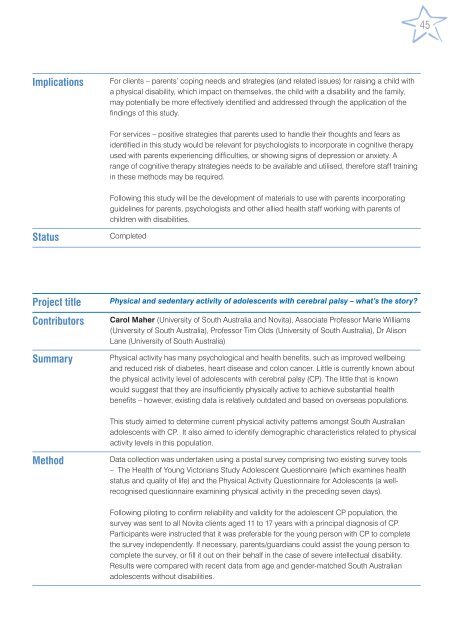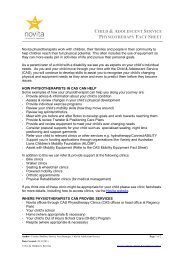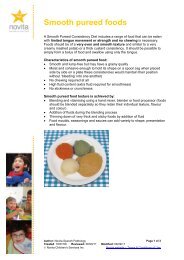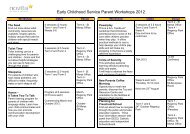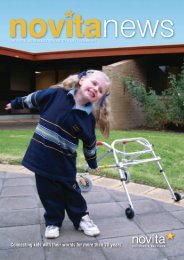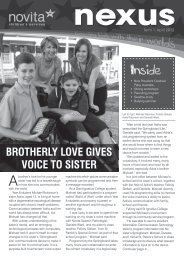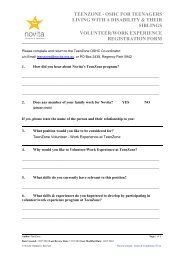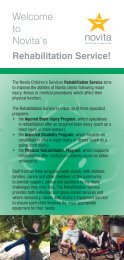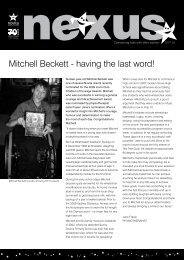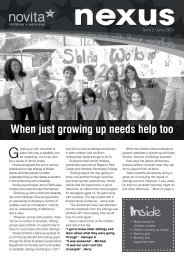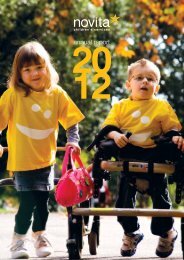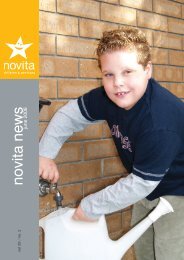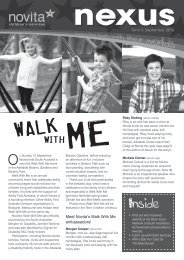Novita Research Report - 2004 to 2007 - Novita Children's Services
Novita Research Report - 2004 to 2007 - Novita Children's Services
Novita Research Report - 2004 to 2007 - Novita Children's Services
- No tags were found...
You also want an ePaper? Increase the reach of your titles
YUMPU automatically turns print PDFs into web optimized ePapers that Google loves.
45ImplicationsFor clients – parents’ coping needs and strategies (and related issues) for raising a child witha physical disability, which impact on themselves, the child with a disability and the family,may potentially be more effectively identified and addressed through the application of thefindings of this study.For services – positive strategies that parents used <strong>to</strong> handle their thoughts and fears asidentified in this study would be relevant for psychologists <strong>to</strong> incorporate in cognitive therapyused with parents experiencing difficulties, or showing signs of depression or anxiety. Arange of cognitive therapy strategies needs <strong>to</strong> be available and utilised, therefore staff trainingin these methods may be required.Following this study will be the development of materials <strong>to</strong> use with parents incorporatingguidelines for parents, psychologists and other allied health staff working with parents ofchildren with disabilities.StatusCompletedProject titleContribu<strong>to</strong>rsSummaryPhysical and sedentary activity of adolescents with cerebral palsy – what’s the s<strong>to</strong>ry?Carol Maher (University of South Australia and <strong>Novita</strong>), Associate Professor Marie Williams(University of South Australia), Professor Tim Olds (University of South Australia), Dr AlisonLane (University of South Australia)Physical activity has many psychological and health benefits, such as improved wellbeingand reduced risk of diabetes, heart disease and colon cancer. Little is currently known aboutthe physical activity level of adolescents with cerebral palsy (CP). The little that is knownwould suggest that they are insufficiently physically active <strong>to</strong> achieve substantial healthbenefits – however, existing data is relatively outdated and based on overseas populations.This study aimed <strong>to</strong> determine current physical activity patterns amongst South Australianadolescents with CP. It also aimed <strong>to</strong> identify demographic characteristics related <strong>to</strong> physicalactivity levels in this population.MethodData collection was undertaken using a postal survey comprising two existing survey <strong>to</strong>ols– The Health of Young Vic<strong>to</strong>rians Study Adolescent Questionnaire (which examines healthstatus and quality of life) and the Physical Activity Questionnaire for Adolescents (a wellrecognisedquestionnaire examining physical activity in the preceding seven days).Following piloting <strong>to</strong> confirm reliability and validity for the adolescent CP population, thesurvey was sent <strong>to</strong> all <strong>Novita</strong> clients aged 11 <strong>to</strong> 17 years with a principal diagnosis of CP.Participants were instructed that it was preferable for the young person with CP <strong>to</strong> completethe survey independently. If necessary, parents/guardians could assist the young person <strong>to</strong>complete the survey, or fill it out on their behalf in the case of severe intellectual disability.Results were compared with recent data from age and gender-matched South Australianadolescents without disabilities.


